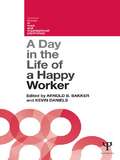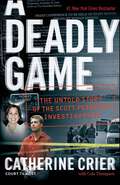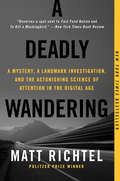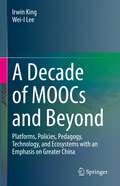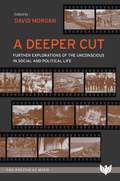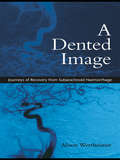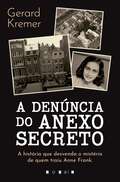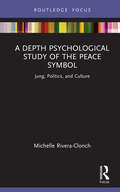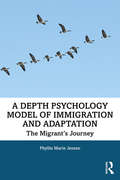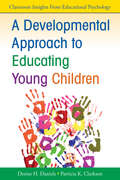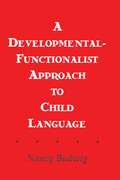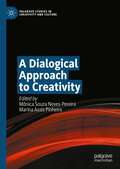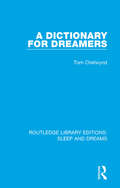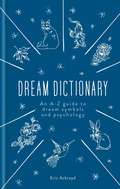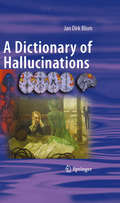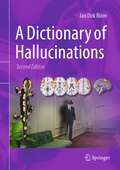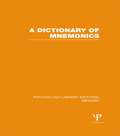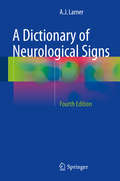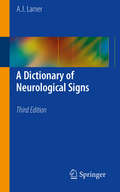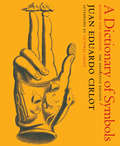- Table View
- List View
A Day in the Life of a Happy Worker
by Edited by Arnold B. Bakker Kevin DanielsThis edited collection brings together some of the leading researchers in the study of the daily experience of work and daily well-being. The book covers both theoretical and methodological issues involved in studying workers’ well-being as it evolves on a daily basis. Interest in the topic of daily fluctuations in worker well-being has grown rapidly over the past ten years. This is partly because of advances in research and statistical methods, but also because researchers have found that the psychological processes that influence well-being play out from moment to moment, and from day to day. Topics covered in this book include: The theoretical basis of studying work as a series of daily episodes Assessment of different components of daily well-being Factors involved in the regulation of well-being at work Qualitative and quantitative diary experience sampling and event reconstruction methods Latent growth curve modelling of diary data The final chapter of the book includes a preview of how daily methods may evolve in the future. Intended as a guide for researchers with good knowledge of field research methods, the book will be particularly useful to researchers of work-related phenomena who seek to expand their knowledge of dynamic methods in field contexts, and those who want to start using these methods. It will also be of interest to students of work psychology and organisational behaviour, and related disciplines.
A Deadly Game: The Untold Story of the Scott Peterson Investigation
by Cole Thompson Catherine CrierIn this #1 New York Times bestseller, Catherine Crier, a former judge and one of television's most popular legal analysts, offers a riveting and authoritative account of one of the most memorable crime dramas of our time: the murder of Laci Peterson at the hands of her husband, Scott, on Christmas Eve 2002. Drawing on extensive interviews with key witnesses and lead investigators, as well as secret evidence files that never made it to trial, Crier traces Scott's bizarre behavior; shares dozens of transcripts of Scott's chilling and incriminating phone conversations; offers accounts of Scott's womanizing from two former mistresses before Amber Frey; and includes scores of never-before-seen police photos, documents, and other evidence.The result is thoroughly engrossing yet highly disturbing -- an unforgettable portrait of a charming, yet deeply sociopathic, killer.
A Deadly Wandering
by Matt RichtelA landmark exploration of the vast and expanding impact of technology, rivetingly told through the lens of a deadly collisionOne of the year's most original and masterfully reported books, A Deadly Wandering by Pulitzer Prize-winning New York Times journalist Matt Richtel interweaves the cutting-edge science of attention with the tensely plotted story of a mysterious car accident and its aftermath to answer some of the defining questions of our time: What is technology doing to us? Can our minds keep up with the pace of change? How can we find balance? Through Richtel's beautifully constructed narrative, a complex and far-reaching topic becomes intimate and urgent--an important call to reexamine our own lives.On the last day of summer, an ordinary Utah college student named Reggie Shaw fatally struck two rocket scientists while texting and driving along a majestic stretch of highway bordering the Rocky Mountains. Richtel follows Reggie from the moment of the tragedy, through the police investigation, the state's groundbreaking prosecution (at the time there was little precedent to guide the court), and ultimately, Reggie's wrenching admission of responsibility. Richtel parallels Reggie's journey with leading-edge scientific findings regarding human attention and the impact of technology on our brains--showing how these devices, now thoroughly embedded into all aspects of our lives, play to our deepest social instincts and prey on parts of the brain that crave stimulation, creating loops of compulsion, even addiction. Remarkably, today Reggie is a leading advocate who has helped spark a national effort targeting distracted driving, and the arc of his story provides a window through which Richtel pursues actionable solutions to help manage this crisis individually and as a society. A propulsive read filled with fascinating scientific detail, riveting narrative tension, and rare emotional depth, A Deadly Wandering is a book that can change--and save--lives.
A Death in the Sanchez Family
by Oscar LewisA Death in the Sanchez family is a short and poignant account of how the poor die—of the death of Aunt Guadalupe, and of her funeral, to which the members of the Sanchez family come as mourners. Jhe Children of Sanchez by Professor Lewis has become an anthropological classic, which is read and studied throughout the world. In this short book Professor Lewis revisits the members of the family, now a few years older, on the occasion of the death of their old aunt. As in his previous books, Professor Lewis allows the members of the family to tell their own stories: their reactions to the funeral and their memories of the impoverished but often heroic life of their deceased aunt. As Professor Lewis writes: "For the poor, death is almost as great a hardship as life itself.” The struggle to get Aunt Guadalupe decently into the earth is one of the themes of this book. But Professor Lewis’ main subject is how her death illuminated her life, and how her life and death reflected the culture of poverty in which she lived.
A Death on Diamond Mountain
by Scott CarneyAn investigative reporter explores an infamous case where an obsessive and unorthodox search for enlightenment went terribly wrong. When thirty-eight-year-old Ian Thorson died from dehydration and dysentery on a remote Arizona mountaintop in 2012, The New York Times reported the story under the headline: "Mysterious Buddhist Retreat in the Desert Ends in a Grisly Death." Scott Carney, a journalist and anthropologist who lived in India for six years, was struck by how Thorson's death echoed other incidents that reflected the little-talked-about connection between intensive meditation and mental instability. Using these tragedies as a springboard, Carney explores how those who go to extremes to achieve divine revelations--and undertake it in illusory ways--can tangle with madness. He also delves into the unorthodox interpretation of Tibetan Buddhism that attracted Thorson and the bizarre teachings of its chief evangelists: Thorson's wife, Lama Christie McNally, and her previous husband, Geshe Michael Roach, the supreme spiritual leader of Diamond Mountain University, where Thorson died. Carney unravels how the cultlike practices of McNally and Roach and the questionable circumstances surrounding Thorson's death illuminate a uniquely American tendency to mix and match eastern religious traditions like LEGO pieces in a quest to reach an enlightened, perfected state, no matter the cost. Aided by Thorson's private papers, along with cutting-edge neurological research that reveals the profound impact of intensive meditation on the brain and stories of miracles and black magic, sexualized rituals, and tantric rites from former Diamond Mountain acolytes, A Death on Diamond Mountain is a gripping work of investigative journalism that reveals how the path to enlightenment can be riddled with danger.
A Decade of MOOCs and Beyond: Platforms, Policies, Pedagogy, Technology, and Ecosystems with an Emphasis on Greater China
by Irwin King Wei-I LeeThis book is an academic publication about the global development of massive open online courses (MOOCs) and major MOOC platforms worldwide in the past decade, as well as the outlook of MOOCs in the future, with an emphasis on Greater China. The book also discusses the upsurge of the demand for online learning and MOOCs during the COVID-19 pandemic.The book is divided into three main parts - Part I: Overview of MOOCs introduces the origin and history of MOOCs and the development of MOOC platforms in Greater China and the global context; Part II: Key Issues discuss the MOOC policies, innovative pedagogy, technology, and ecosystems worldwide; and Part III: Beyond MOOCs probes into the roles and benefits of MOOCs in times of crises, as well as the outlook of MOOCs in the future. In terms of topic diversity, the book contains a comprehensive investigation of the past and latest MOOC developments, extracting and elaborating on relevant information regarding platforms, policies, pedagogy, technology, and ecosystems. Subsequently, in-depth analyses of MOOC data are utilized to deduce the current trends related to the MOOC movement and to extrapolate the likeliest direction of development for MOOCs in the years to come. The book can inform policymakers, education institutions, course instructors, platform developers, investors, researchers, and individual learners of MOOCs about critical information on the present and future of MOOC development, assisting them in making crucial decisions on what initiatives can optimize their advantages in the sector.
A Deeper Cut: Further Explorations of the Unconscious in Social and Political Life
by David MorganBuilding on the bestselling The Unconscious in Social and Political Life, the first book in the Political Minds series, A Deeper Cut investigates such vital issues as left and right populisms, colonialism and racism, social care for the mentally ill, manipulation of the masses in the third world, Alice Miller on family politics, diversity, Orwellian thinking, trade unions, religious fundamentalism, NHS politics, activism, and tyranny. Featuring compelling contributions from Lord John Alderdice, Elizabeth Cotton, Tomasz Fortuna, Stephen Frosh, Samir Gandesha, Mary Joan Gerson, Liz Greenway, Roger Hartley, Luisa Passalacqua, Kate Pugh, Marco Puricelli, Edgard Sanchez Bernal, Elisabeth Skale, Mark Stein, and Margot Waddell. Galvanised by events outside of his consulting room, David Morgan began The Political Mind seminars at the British Psychoanalytical Society in 2015 and their successful run continues today. A series of superlative seminars that examine the effects of the current upheaval going on worldwide, this book is the second to bring these seminars from leading thinkers to a wider audience. Leading politicians, writers, educators, psychoanalysts, psychologists, philosophers, psychotherapists, and psychologists are gathered together in this fascinating volume that investigates social upheaval on the worldwide stage. Stimulating and thought-provoking, this is a must-read for every citizen asking just what is happening in the world today.
A Dented Image: Journeys of Recovery from Subarachnoid Haemorrhage
by Alison WertheimerEvery year, 8,500 people in the UK will have a subarachnoid haemorrhage, of whom about 50 per cent will survive this traumatic brain injury which often occurs without warning. Survivors can make a ‘good’ neurological recovery but the psychosocial impact can be longer lasting. Drawing from her own experience of surviving a subarachnoid haemorrhage, together with other people's journeys of recovery and recent research findings, Alison Wertheimer covers: themes of recovery leaving neurocare and early days of recovery looking for help physical, sensory and cognitive effects the emotional impact of subarachnoid haemorrhage the survivor’s relationship with family and friends returning to work what helped the survivors with their recovery subarachnoid haemorrhage as a life-changing event. A Dented Image will be of interest to a wide-ranging audience: survivors and their families and friends; health professionals working with people recovering from acute brain injury in hospital and community-based services including doctors, nurses, psychologists, physiotherapists, occupational therapists and other members of rehabilitation teams. It may also be of interest to people recovering from other traumatic illnesses or injuries.
A Denúncia do Anexo Secreto: A História Que Desvenda o Mistério de Quem Traiu Anne Frank
by Gerard KremerUma história baseada em factos reais que apresenta novas evidências sobre quem denunciou o esconderijo da família de Anne Frank. Quando Gerard Kremer, em 1941, se torna zelador de um prédio de escritórios em Amesterdão, próximo do que hoje é conhecido como Anexo Secreto — o refúgio de Anne Frank e da família entre 1942 e 1944 —, não tem ideia do papel que viria a desempenhar na cidade ocupada pelos nazis. Devido às circunstâncias, e porque não consegue fechar os olhos ao que está a acontecer em seu redor, Gerard acaba por integrar gradualmente a Resistência. Em 1942, as coisas complicam-se, quando as Forças Armadas alemãs ocupam parte do prédio onde Gerard trabalha. Nessa altura, ao descobrir na cave do prédio um grande armazenamento de mantimentos destinados aos alemães, Gerard decide começar a desviar alguma comida para ajudar os judeus, dando igualmente abrigo a algumas famílias judias. Gerard sabe que está a envolvido num jogo que é cada vez mais perigoso, e isso quase o mata, mas nada o impedirá de lutar por aquilo que acredita ser o seu dever.
A Depth Psychological Study of the Peace Symbol: Jung, Politics and Culture (Focus on Jung, Politics and Culture)
by Michelle Rivera-ClonchThis engaging new book uncovers the cultural context behind the peace symbol’s emergence, its growing significance in the 1960s, and its ongoing presence in today’s worldwide grassroots and nonviolent social action protests. Since its debut in 1958, the peace symbol has become a ubiquitous presence in broadcasted images of protest and resistance, yet most citizens are unaware of the symbol’s history or psychological evolution. It is a unique modern symbol in that it is at once an omnipresent and yet entirely unknown entity. This noteworthy text engages readers in fresh and thought-provoking ways around the interdependent relationships of peace and war, recognition and secrets, symbol and chaos, and action and inaction to name a few. In this book, Rivera-Clonch brings a depth psychological analysis to Post-World War II’s escalating nuclear tensions and rhetoric and links it to today’s increasing consciousness around social injustices and nonviolent activism. This is a timely and relevant interdisciplinary case study exploring the peace symbol through the dimensions of cultural secrets and psychological shadow, nuclearized storytelling and symbology, and grassroots nonviolent social action. A Depth Psychological Study of the Peace Symbol will be of interest to Jungian and depth psychologists, as well as students and scholars of peace studies and psychology.
A Depth Psychology Model of Immigration and Adaptation: The Migrant's Journey
by Phyllis Marie JensenA Depth Psychology Study of Immigration and Adaptation: The Migrant’s Journey brings current academic research from a range of disciplines into a 12-stage model of human migration. Based on Joseph Campbell’s hero’s journey, this depth psychology model addresses pre-migration reasons for leaving, the ordeals of the journey and challenges of post-migration adaptation. One-third of migrants return to homelands while those who remain in newlands face the triple challenges of building a new life, a new identity and sense of belonging. While arrivées carry homelands within, their children, the second generation, born and raised in the newland usually have access to both cultures which enables them to make unique contributions to society. Vital to successful newland adaptation is the acceptance and support of immigrants by host countries. A Depth Psychology Study of Immigration and Adaptation will be an important resource for academics and students in the social sciences, clinical psychologists, health care and social welfare workers, therapists of all backgrounds, policy makers and immigrants themselves seeking an understanding of the inner experiences of migration.
A Developmental Approach to Educating Young Children
by Patricia K. Clarkson Denise DanielsLaunch young learners on positive pathways through school! The first in the Classroom Insights From Educational Psychology series, this book gives PreK–3 teachers valuable insight into how current research and theory from educational psychology can be applied to create a child-centered learning environment. Through vignettes, practice exercises, games, and reflection questions, readers gain a deeper understanding of: How children develop from the early years to middle childhood; The importance of fostering positive teacher-child, child-child, and caregiver-child relationships; Developmentally appropriate classroom practices that foster learning; Children’s experiences with technology and outdoor environments.
A Developmental-functionalist Approach To Child Language
by Nancy BudwigAlthough there has been much empirical study within what has been referred to as "functional approaches to child language," there has yet to be a major attempt to compare and contrast such proposals. In addition, much of the work carried out within child language from a functionalist perspective has not been specific with regard to the nature of the approach adopted. In attempting to fill the gap, the author of this book begins with a comparison of various functionalist approaches. By concentrating on one domain -- agentivity and control -- Budwig develops a set of research questions based on an examination of findings stemming from linguistics, psycholinguistics, and developmental psychology, and also provides an in-depth discussion of related methodological issues. In the second part of the book, she traces the development of linguistic means to refer to oneself within a developmental-functionalist perspective. Individual case studies as well as group analyses of six children in the early phases of acquiring English grammar are provided. In the last part, Budwig examines the relationship between forms and functions in development with special attention to potential generalizations about the organization and reorganization of the children's linguistic systems.
A Developmentalist's Guide to Better Mental Health: Navigating Everyday Life Dilemmas
by Lois HolzmanA Developmentalist’s Guide to Better Mental Health offers mental health professionals a practical, philosophical, and playful guide for working relationally and developmentally with dilemmas, muddles, and the emotions that accompany them.The book centers around dozens of letters from writers asking “the developmentalist” for help with a wide range of issues. Organized by topics and themes—including trauma, family and relationship issues, living with uncertainty, workplace problems, and more—the letters and the developmentalist's thoughtful, thought-provoking responses lay out a wide variety of strategies for inviting clients into developmental journeys. When shared with clients, the letters and responses are a rich resource for therapeutic conversations. The book includes theoretical and conceptual background information as well as commentary from mental health professionals who already use the letters and responses in their practices.A Developmentalist’s Guide to Better Mental Health is unlike other practical guides in both its format and in its focus on development, especially emotional and social development, as a creative activity.
A Dialectical Journey through Fashion and Philosophy
by Eun Jung KangThis book takes an in-depth look at the integration of fashion and philosophy. It challenges the deeply rooted prejudice or misconception that fashion is a field limited to body-oriented and appearance-related themes and practices. It also reveals that fashion is intermeshed with distinctively modern issues that belong to the realm of the mind as well as the body. In doing so, it refashions philosophy and philosophizes fashion, which ultimately amount to the same thing. The book argues that while the philosophization of fashion can give a clearer understanding of some esoteric areas of philosophy and fashion’s close connection to modern societies and politics, it also shows that philosophy can assist in redeeming fashion from the objective, bodily world, positioning it as an indispensable part of the humanities. This is because fashion manifests critical aspects of human culture in our time, and is an expression of the zeitgeist, which is interwoven with the unfolding of history. This book will be highly relevant to students and researchers in fashion studies who are looking for the theoretical underpinnings and insights for their own work. It will also be of keen interest to scholars in the field of philosophy who are seeking to apply philosophical concepts to both everyday life and our empirical world.
A Dialogical Approach to Creativity (Palgrave Studies in Creativity and Culture)
by Marina Assis Pinheiro Mônica Souza Neves-PereiraThis book takes an epistemological and theoretical stance in investigating the phenomenon of creativity and its processes. Creativity is analyzed through the lens of cultural psychology, in which psychological processes emerge over the course of life, and can only be understood in relation to the subject’s history and life experiences. Dialogism is presented as central for the constitutive dynamics of the developing subject and the emergence of creative actions through the expression of human agency. The authors highlight Bakhtinian dialogism and its developments in the scientific field of psychology and related areas to shed new light on creativity and its processes. The authors argue this will enable a better understanding of creativity in its development and emergence, and its impact on individuals and society.
A Dictionary for Dreamers (Routledge Library Editions: Sleep and Dreams #2)
by Tom ChetwyndOriginally published in Great Britain in 1972 and distilled from the collective wisdom of the great interpreters of dreams – Freud, Jung, Adler, Stekel and Gutheil, among others – this comprehensive key to the baffling language of dream symbolism is a thought-provoking and invaluable guide to the uncharted country of the mind. Tom Chetwynd has isolated for the first time the rich meanings of over 500 archetypal symbols from the indiscriminate mass of dream material, and rated the likelihoods of the various possible interpretation in each case. Here are the essential clues to understanding the ingeniously disguised, life-enriching, often urgent messages to be found in dreams.
A Dictionary of Dream Symbols: With an Introduction to Dream Psychology
by Eric AckroydDid you know that dreams about houses symbolise exploration of the self. And that water symbolises fertility, creativity and potential. Dreams provide vital clues to hidden feelings, fears and desires; understanding your dreams can lead to greater self-awareness and self-healing. Each image that appears in a dream has a meaning and The Dream Dictionary is an invaluable, detailed guide to decoding these meanings.The book introduces the classic theories of Freud and Jung, to more recent ideas on dream analysis, it provides a wealth of background information on the study of dreams and on the images examined in the dictionary section. From abandonment to zodiacal signs, the comprehensive dictionary has more than 700 entries. Each entry gives a range of possible interpretations for a particular dream symbol, allowing you wide scope for deciphering your dream and for assessing its implications. Cross-referencing throughout, the dictionary allows you to examine all aspects of individual symbols.
A Dictionary of Dream Symbols: With an Introduction to Dream Psychology
by Eric AckroydDid you know that dreams about houses symbolise exploration of the self. And that water symbolises fertility, creativity and potential. Dreams provide vital clues to hidden feelings, fears and desires; understanding your dreams can lead to greater self-awareness and self-healing. Each image that appears in a dream has a meaning and The Dream Dictionary is an invaluable, detailed guide to decoding these meanings.The book introduces the classic theories of Freud and Jung, to more recent ideas on dream analysis, it provides a wealth of background information on the study of dreams and on the images examined in the dictionary section. From abandonment to zodiacal signs, the comprehensive dictionary has more than 700 entries. Each entry gives a range of possible interpretations for a particular dream symbol, allowing you wide scope for deciphering your dream and for assessing its implications. Cross-referencing throughout, the dictionary allows you to examine all aspects of individual symbols.
A Dictionary of Hallucinations
by Jan Dirk BlomA Dictionary of Hallucinations is designed to serve as a reference manual for neuroscientists, psychiatrists, psychiatric residents, psychologists, neurologists, historians of psychiatry, general practitioners, and academics dealing professionally with concepts of hallucinations and other sensory deceptions.
A Dictionary of Hallucinations
by Jan Dirk BlomThe Dictionary of Hallucinations, second edition, is an alphabetical listing of issues pertaining to hallucinations and other misperceptions. They can be roughly divided into four categories: 1. Definitions of individual hallucinatory symptoms2. Medical conditions and substances associated with the mediation of hallucinations3. Historical figures who are known to have experienced hallucinations4. Miscellaneous issues Each of the definitions of individual hallucinatory symptoms includes: a definition of the termits etymological originthe year of introduction (if known)a reference to the author or authors who introduced the term (if known)a description of the current usea brief explanation of the etiology and pathophysiology of the symptom at hand (if known)references to related termsreferences to the literature The second edition of A Dictionary of Hallucinations serves as a reference manual for neuroscientists, psychiatrists, psychiatric residents, psychologists, neurologists, historians of psychiatry, general practitioners, and academics dealing professionally with concepts of hallucinations and other sensory deceptions. This new edition provides updated information and references, and includes newly discovered hallucinations, bringing together contributions by other authorities within the field, with all the entries edited by Prof. Blom.
A Dictionary of Mnemonics (Psychology Library Editions: Memory)
by VariousThe Greeks invented them. All manner of people in the European Middle Ages used them, often with creative and brilliant effect. Victorian schoolmasters in England almost buried them and the pupils who had to cram facts parrot-fashion. Originally published in 1972, this title brought mnemonics back into focus with a new collection designed for current use. A mnemonic is anything that gets your memory working. When in the month does the third quarter-day fall? What order have the planets from the sun? Are you sure about the kings and queens of England? People nowadays have so much to remember that even those quite happy with √2 = 1.414 may prefer to chant ‘I wish I know the root of two’ and remind themselves in that way. Although some entries are very much of their time, this title reminds us that mnemonics are still a useful tool in a world where technology means most people feel they have little need to remember.
A Dictionary of Neurological Signs, 4th Edition: Clinical Neurosemiology
by A. J. LarnerThis updated and expanded Fourth Edition is an alphabetical listing of commonly presenting neurological signs designed to guide the physician toward the correct clinical diagnosis. The dictionary is focused, problem-based and concise. <P><P> The structured entries in this practical, clinical resource provide summaries of a wide range of neurological signs. Each entry includes: a definition of the sign; a brief account of the clinical technique required to elicit the sign; a description of the other signs which may accompany the index sign; an explanation of pathophysiological and/or pharmacological background; differential diagnosis; brief treatment details; and where known, the neuroanatomical basis of the sign. <P><P> A Dictionary of Neurological Signs, Fourth Edition, is an indispensable reference for all students, trainees, and clinicians who care for patients with neurological disorders, and could also be used in preparation for exams, since each entry is a snapshot of a specific disorder or disease.
A Dictionary of Neurological Signs, Third Edition
by A. J. LarnerThe first two editions of the Dictionary of Neurological Signs were very well-received by readers and reviewers alike. Like those editions, this Third Edition, updated and expanded, can be almost as well described in terms of what the book is not, along with details about what it is. The Dictionary is not a handbook for treatment of neurological disorders. While many entries provide the latest treatment options, up-to-the-minute therapies are not discussed in bedside level detail. The Dictionary is not a board review book because it is not in Q&A format but could easily serve in that capacity since each entry is a fairly complete snapshot of a specific disorder or disease. The Dictionary is an alphabetical listing of commonly presenting neurological signs designed to guide the physician toward the correct clinical diagnosis. The Dictionary is focused, problem-based, concise and practical. The structured entries in this practical, clinical resource provide a thumbnail of a wide range of neurological signs. Each entry includes: * A definition of the sign * A brief account of the clinical technique required to elicit the sign * A description of the other signs which may accompany the index sign * An explanation of pathyophysiological and/or pharmacological background * Differential diagnosis * Brief treatment details Where known, these entries also include the neuroanatomical basis of the sign. The Dictionary of Neurological Signs, Third Edition, is an indispensable reference for all students, trainees, and clinicians who care for patients with neurological disorders.
A Dictionary of Symbols: Revised and Expanded Edition
by Juan Eduardo CirlotA classic encyclopedia of symbols by Catalan polymath Joan Cirlot that illuminates the symbolic underpinnings of myth, modern psychology, literature, and art.Juan Eduardo Cirlot&’s A Dictionary of Symbols is a feat of scholarship, an act of the imagination, and a tool for contemplation, as well as a work of literature, a reference book that is as indispensable as it is brilliant and learned. Cirlot was a composer, a poet, an art critic, and a champion of modern art whose interest in surrealism helped to bring him to the study of symbolism. Carl Jung, Mircea Eliade, René Guénon, Erich Fromm, and Gaston Bachelard also helped to shape his thinking in a book that explores the space between the world at large and the world within, where, as Cirlot sees it, nothing is meaningless, everything is significant, and everything is in some way related to something else. Running from &“abandonment&” to &“zone&” by way of &“flute&” and &“whip,&” spanning the cultures of the world, and including a wealth of visual images to further bring the reality of the symbol home, A Dictionary of Symbols, here published for the first time in English in its original, significantly enlarged form, is a luminous and illuminating investigation of the works of eternity in time.
